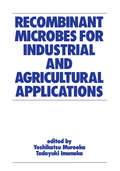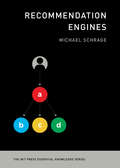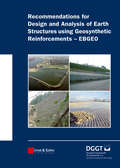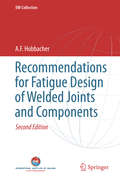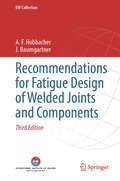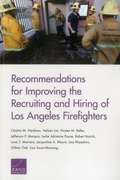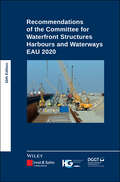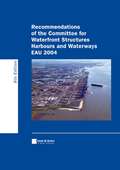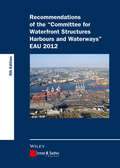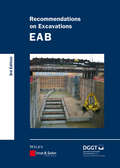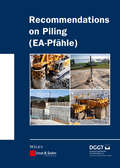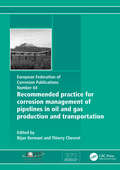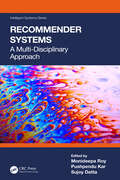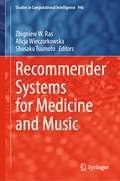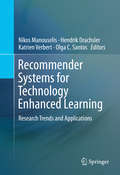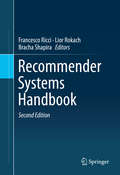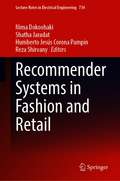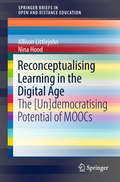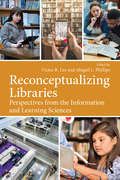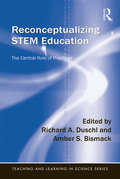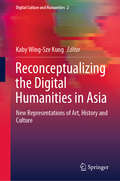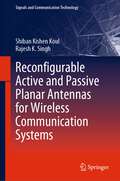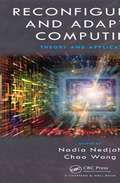- Table View
- List View
Recombinant Microbes for Industrial and Agricultural Applications
by Yoshikatsu Murooka, Tadayuki lmanakaBridging the gap between laboratory observations and industrial practices, this work presents detailed information on recombinant micro-organisms and their applications in industry and agriculture. All recombinant microbes, bacteria, yeasts and fungi are covered.
Recommendation Engines (The MIT Press Essential Knowledge series)
by Michael SchrageHow companies like Amazon, Netflix, and Spotify know what "you might also like": the history, technology, business, and societal impact of online recommendation engines.Increasingly, our technologies are giving us better, faster, smarter, and more personal advice than our own families and best friends. Amazon already knows what kind of books and household goods you like and is more than eager to recommend more; YouTube and TikTok always have another video lined up to show you; Netflix has crunched the numbers of your viewing habits to suggest whole genres that you would enjoy. In this volume in the MIT Press's Essential Knowledge series, innovation expert Michael Schrage explains the origins, technologies, business applications, and increasing societal impact of recommendation engines, the systems that allow companies worldwide to know what products, services, and experiences "you might also like."
Recommendations for Design and Analysis of Earth Structures using Geosynthetic Reinforcements - EBGEO
by the German Geotechnical SocietyThe completely revised and extended Recommendations deal with all questions relevant to the planning and dimensioning of geosynthetics-reinforced earth structures. In addition to the demands on materials and analysis principles, the applications of geosynthetics in a range of foundation systems, ground improvement measures, highways engineering projects, in slopes and retaining structures, and in landfill engineering are discussed. The Recommendations have been supplemented by the following sections: - reinforced earth structures over point or linear bearing elements, - foundation systems using geotextile-encased columns, - bridging subsidence, - dynamic actions of geosynthetic-reinforced systems. The remaining sections have been fundamentally revised and updated in line with current standards and codes of practice.
Recommendations for Fatigue Design of Welded Joints and Components (IIW Collection)
by A. F. HobbacherThis book provides a basis for the design and analysis of welded components that are subjected to fluctuating forces, to avoid failure by fatigue. It is also a valuable resource for those on boards or commissions who are establishing fatigue design codes. For maximum benefit, readers should already have a working knowledge of the basics of fatigue and fracture mechanics. The purpose of designing a structure taking into consideration the limit state for fatigue damage is to ensure that the performance is satisfactory during the design life and that the survival probability is acceptable. The latter is achieved by the use of appropriate partial safety factors. This document has been prepared as the result of an initiative by Commissions XIII and XV of the International Institute of Welding (IIW).
Recommendations for Fatigue Design of Welded Joints and Components (IIW Collection)
by A. F. Hobbacher J. BaumgartnerThis book presents an enriched exploration of structural fatigue assessment. Now in its updated form, this comprehensive edition delves into foundational principles while introducing extensive revisions and fresh content. Notable enhancements include a refined discussion on stress determination, an expanded section on fatigue resistance, also for welded thin sheets, and a thorough update of crucial chapters such as fatigue assessment using S-N curves at constant and variable amplitudes as well as practical application of fracture mechanics on fatigue of welded joints. The addition of new chapters on high-frequency mechanical impact (HFMI) treatment, insightful statistical considerations based on IIW recommendations, and practical application examples further distinguish this edition. With updated references and meticulous attention to detail, this new edition emerges as an indispensable resource, offering professionals and enthusiasts a deeper understanding of fatigue assessment in structural engineering. Prepared as the result of an initiative by Commissions XIII and XV of the International Institute of Welding (IIW), this book represents a significant contribution to the field.
Recommendations for Improving the Recruiting and Hiring of Los Angeles Firefighters
by Chaitra M. Hardison Nelson Lim Kirsten M. Keller Jefferson P. Marquis Leslie Adrienne Payne Robert Bozick Louis T. Mariano Jacqueline A. Mauro Lisa Miyashiro Gillian Oak Lisa Saum-ManningReviews the Los Angeles Fire Department's hiring practices as of June 2014 and outlines a recommended new firefighter hiring process that is intended to increase efficiency of the hiring process, bolster the evidence supporting the validity of it, and make it more transparent and inclusive.
Recommendations of the Committee for Waterfront Structures Harbours and Waterways: EAU 2020
by HTG Deutsche Gesellschaft für GeotechnikThe recommendations have been completely restructured in this 12th (2020) edition of the EAU (10th English edition), the aim being to provide readers with a better, clearer arrangement of the chapters. In addition, the information published in the annual technical reports of the Waterfront Structures Committee since the publication of the 11th German edition have been incorporated in this new edition. The recommendations also take into account the new generation of standards consisting of Eurocode 7, the associated National Application Documents and supplementary national publications (DIN 1054:2010). In isolated instances, partial safety factors differing from those in the codes are specified on the basis of practical experience. Safety standards for ports, harbours and marine structures are therefore upheld. The recommendations satisfy the need for international acceptance in the planning, design, tendering, award of contract, construction, site supervision, acceptance and settlement of accounts for port, harbour and waterway facilities based on uniform approaches.
Recommendations of the Committee for Waterfront Structures Harbours and Waterways EAU 2004
by Mary RudolfSince 1949 the "Committee for Waterfront Structures" has operated on honorary base as a committee of the Society for Harbour Engineering (HTG), Hamburg, and since 1951 also as working group of the German Society for Geotechnics (DGGT), Essen. Its full designation reads "Committee for Simplification an Standardization of Calculation and Construction of Waterfront Structures", which also outlines its goals. Following on from the previous joint publications, this new edition of EAU 2004 contains the safety concept with partial safety factors in accordance with the Eurocodes or the European prestandards as well as with the new edition of the corresponding German standard, partially differing on account of practice experiences. The recommendations continue to satisfy the requirements for international acknowledgement and application with regard to planning, design tendering, the awarding of contracts, building and building supervision. Further, the inspection and accounting procedures for harbour and waterway constructions are given from uniform points of view.
Recommendations of the Committee for Waterfront Structures Harbours and Waterways EAU 2012
by HTGThe "EAU 2012" takes into account the new generation of standards, which is shortly to be introduced into the building control system; it consists of Eurocode 7, the associated national application documents and additional national regulations (DIN 1054:2010). In certain cases, partial safety factors are determined differently based on experience in practice. This means that the safety standard of sea and port buildings remains in place; the recommendations nevertheless satisfy the requirements for international recognition and application regarding the planning, design, specification, tender procedure, construction and monitoring, as well as the handover of - and cost accounting for - port and waterway systems under uniform criteria.
Recommendations on Excavations 3e
by Alan Johnson Deutsche Gesellschaft für Geotechnik e.V. / German Geotechnical SocietyWith the issue of these recommendations, which have the character of a standard, the "Building Excavations" working group of the German Geotechnics Association (DGGT) aims to provide assistance with the design and structural calculation of excavation support works.The introduction of the Eurocodes for building control purposes made necessary a revision of the previous edition of the recommendations to comply with the requirements of DIN EN 1997-1:2009 together with the national annex DIN 1997-1/NA:2010-12 and the supplementary regulations of DIN 1054:2010-12. All recommendations were thoroughly checked, revised where necessary and adapted to new knowledge. Chapter 10 "Building excavations in water" was substantially revised. Due to the progress of development of measurement instruments and the more stringent requirements, Chapter 14 "Instrumentation for the monitoring and supervision of building excavation support works" was formulated completely anew. The recommendations of the working group "Building Excavations" should be of assistance,- to simplify the design and structural calculation of excavation support works,- to harmonise loading assumptions and calculation procedures,- to ensure the structural stability of excavation support works and their individual elements and- to improve the cost-effectiveness of excavation support works.
Recommendations on Piling (EA Pfähle)
by Alan Johnson Deutsche Gesellschaft für Geotechnik e.V. / German Geotechnical SocietyThis handbook provides a complete and detailed overview of piling systems and their application. <P><P>The design and construction of piled foundations is based on Eurocode 7 and DIN 1054 edition 2010 as well as the European construction codes DIN EN 1536 (Bored piles), DIN EN 12699 (Displacement piles) and DIN EN 14199 (Micropiles). These recommendations also deal with - categorisation of piling systems, - actions on piles from structural loading, negative skin friction and side pressure, - pile resistances from static and dynamic pile test loading as well as extensive tables with the pile load-bearing capacity of nearly all piling systems based on values from practical experience, - pile groups, - performance of static and dynamic test loading and integrity tests, - load-bearing behaviour and verifications for piles under cyclical, dynamic and impact actions - quality assurance for construction. An appendix with numerous calculation examples completes the work. As part of the approval procedure for offshore wind energy structures, the Federal Office for Shipping and Hydrography (BSH) demands verifications according to the new Chapter 13 ("Load-bearing behaviour and verifications for piles under cyclical, dynamical and impact actions") of the EA Pfähle (the recommendations of the Piling working group - 2nd edition), which deals with external pile resistance for the foundations of offshore wind energy structures and the types of verifications to be provided under cyclical actions. The publication of the EA-Pfähle recommendations by the Piling working group of the German Society for Geotechnics (DGGT), which works with the same members as the piling standards committee NA 00-05-07, is intended to provide assistance for engineers active in the design, calculation and construction of piled foundations. The recommendations can thus be considered as rules of the technology and as a supplement to the available codes and standards.
Recommended Practice for Corrosion Management of Pipelines in Oil & Gas Production and Transportation (European Federation Of Corrosion Publications)
by Bijan KermaniFirst Published in 2017. Pipeline integrity is key to maintaining operational success, safety and security and minimising harm to the environment. Corrosion is a dominant contributory factor to failures, leaks and integrity threats in pipelines. Therefore, its optimum control within an integrity management framework is paramount for the cost-effective design of facilities and ensuring continued, uninterrupted and safe operations within the expected design life. This recommended practice (RP) is a compendium of current best practices and state-of-the-art knowledge by major operators, engineering contractors and service companies involved in hydrocarbon pro-duction and transportation. The RP incorporates some minimum operational requirements and practices to ensure that when man-aging corrosion in pipelines, fundamental principles are followed. It covers management of corrosion for pipelines carrying hydrocarbons, injection water and/or produced water from design to decommissioning. It is structured to follow the logical steps of a basic corrosion management process and makes references to relevant and available international standards and/or recommended practices. It is intended for use by personnel from the petroleum industry having knowledge of corrosion and materials. It is hoped that this RP will prove to be a key reference document for engineers, suppliers and con-tractors working in the oil and gas industry, paving the way for corrosion-free operation of pipelines with the ultimate goal of improving safety, security and minimising the impact on the environment
Recommender Systems
by Dietmar Jannach Markus Zanker Alexander Felfernig Gerhard FriedrichIn this age of information overload, people use a variety of strategies to make choices about what to buy, how to spend their leisure time, and even whom to date. Recommender systems automate some of these strategies with the goal of providing affordable, personal, and high-quality recommendations. This book offers an overview of approaches to developing state-of-the-art recommender systems. The authors present current algorithmic approaches for generating personalized buying proposals, such as collaborative and content-based filtering, as well as more interactive and knowledge-based approaches. They also discuss how to measure the effectiveness of recommender systems and illustrate the methods with practical case studies. The final chapters cover emerging topics such as recommender systems in the social web and consumer buying behavior theory. Suitable for computer science researchers and students interested in getting an overview of the field, this book will also be useful for professionals looking for the right technology to build real-world recommender systems.
Recommender Systems: A Multi-Disciplinary Approach (Intelligent Systems)
by Monideepa Roy Pushpendu Kar Sujoy DattaRecommender Systems: A Multi-Disciplinary Approach presents a multi-disciplinary approach for the development of recommender systems. It explains different types of pertinent algorithms with their comparative analysis and their role for different applications. This book explains the big data behind recommender systems, the marketing benefits, how to make good decision support systems, the role of machine learning and artificial networks, and the statistical models with two case studies. It shows how to design attack resistant and trust-centric recommender systems for applications dealing with sensitive data. Features of this book: Identifies and describes recommender systems for practical uses Describes how to design, train, and evaluate a recommendation algorithm Explains migration from a recommendation model to a live system with users Describes utilization of the data collected from a recommender system to understand the user preferences Addresses the security aspects and ways to deal with possible attacks to build a robust system This book is aimed at researchers and graduate students in computer science, electronics and communication engineering, mathematical science, and data science.
Recommender Systems for Medicine and Music (Studies in Computational Intelligence #946)
by Zbigniew W. Ras Alicja Wieczorkowska Shusaku TsumotoMusic recommendation systems are becoming more and more popular. The increasing amount of personal data left by users on social media contributes to more accurate inference of the user’s musical preferences and the same to quality of personalized systems. Health recommendation systems have become indispensable tools in decision making processes in the healthcare sector. Their main objective is to ensure the availability of valuable information at the right time by ensuring information quality, trustworthiness, authentication, and privacy concerns. Medical doctors deal with various kinds of diseases in which the music therapy helps to improve symptoms. Listening to music may improve heart rate, respiratory rate, and blood pressure in people with heart disease. Sound healing therapy uses aspects of music to improve physical and emotional health and well-being. The book presents a variety of approaches useful to create recommendation systems in healthcare, music, and in music therapy.
Recommender Systems for Technology Enhanced Learning
by Nikos Manouselis Hendrik Drachsler Katrien Verbert Olga C. SantosAs an area, Technology Enhanced Learning (TEL) aims to design, develop and test socio-technical innovations that will support and enhance learning practices of individuals and organizations. Information retrieval is a pivotal activity in TEL and the deployment of recommender systems has attracted increased interest during the past years. Recommendation methods, techniques and systems open an interesting new approach to facilitate and support learning and teaching. The goal is to develop, deploy and evaluate systems that provide learners and teachers with meaningful guidance in order to help identify suitable learning resources from a potentially overwhelming variety of choices. Contributions address the following topics: i) user and item data that can be used to support learning recommendation systems and scenarios, ii) innovative methods and techniques for recommendation purposes in educational settings and iii) examples of educational platforms and tools where recommendations are incorporated.
Recommender Systems Handbook
by Francesco Ricci Lior Rokach Bracha ShapiraThis second edition of a well-received text, with 20 new chapters, presents a coherent and unified repository of recommender systems' major concepts, theories, methodologies, trends, and challenges. A variety of real-world applications and detailed case studies are included. In addition to wholesale revision of the existing chapters, this edition includes new topics including: decision making and recommender systems, reciprocal recommender systems, recommender systems in social networks, mobile recommender systems, explanations for recommender systems, music recommender systems, cross-domain recommendations, privacy in recommender systems, and semantic-based recommender systems. This multi-disciplinary handbook involves world-wide experts from diverse fields such as artificial intelligence, human-computer interaction, information retrieval, data mining, mathematics, statistics, adaptive user interfaces, decision support systems, psychology, marketing, and consumer behavior. Theoreticians and practitioners from these fields will find this reference to be an invaluable source of ideas, methods and techniques for developing more efficient, cost-effective and accurate recommender systems.
Recommender Systems in Fashion and Retail (Lecture Notes in Electrical Engineering #734)
by Nima Dokoohaki Shatha Jaradat Humberto Jesús Corona Pampín Reza ShirvanyThis book includes the proceedings of the second workshop on recommender systems in fashion and retail (2020), and it aims to present a state-of-the-art view of the advancements within the field of recommendation systems with focused application to e-commerce, retail, and fashion by presenting readers with chapters covering contributions from academic as well as industrial researchers active within this emerging new field. Recommender systems are often used to solve different complex problems in this scenario, such as product recommendations, or size and fit recommendations, and social media-influenced recommendations (outfits worn by influencers).
Reconceptualising Learning in the Digital Age: The [un]democratising Potential Of Moocs (SpringerBriefs in Education)
by Allison Littlejohn Nina HoodThis book situates Massive Open Online Courses and open learning within a broader educational, economic and social context. It raises questions regarding whether Massive Open Online Courses effectively address demands to open up access to education by triggering a new education order, or merely represent reactionary and unimaginative responses to those demands. It offers a fresh perspective on how we conceptualise learners and learning, teachers and teaching, accreditation and quality, and how these dimensions fit within the emerging landscape of new forms of open learning.
Reconceptualizing Libraries: Perspectives from the Information and Learning Sciences
by Victor R. Lee Abigail L. PhillipsReconceptualizing Libraries brings together cases and models developed by experts in the information and learning sciences to identify the potential for libraries to adapt and transform in the wake of new technologies for connected learning and discovery. Chapter authors explore the ways that the increased interest in the design research methods, digital media emphases, and technological infrastructure of the learning sciences can foster new collaborations and formats for education within physical library spaces. Models and case studies from a variety of library contexts demonstrate how library professionals can act as change agents and design partners and how patrons can engage with these evolving experiences. This is a timely and innovative volume for understanding how physical libraries can incorporate and thrive as educational resources using new developments in technology and in the learning sciences.
Reconceptualizing STEM Education: The Central Role of Practices (Teaching and Learning in Science Series)
by Richard A. Duschl Amber S. BismackReconceptualizing STEM Education explores and maps out research and development ideas and issues around five central practice themes: Systems Thinking; Model-Based Reasoning; Quantitative Reasoning; Equity, Epistemic, and Ethical Outcomes; and STEM Communication and Outreach. These themes are aligned with the comprehensive agenda for the reform of science and engineering education set out by the 2015 PISA Framework, the US Next Generation Science Standards and the US National Research Council’s A Framework for K-12 Science Education. The new practice-focused agenda has implications for the redesign of preK-12 education for alignment of curriculum-instruction-assessment; STEM teacher education and professional development; postsecondary, further, and graduate studies; and out-of-school informal education. In each section, experts set out powerful ideas followed by two eminent discussant responses that both respond to and provoke additional ideas from the lead papers. In the associated website highly distinguished, nationally recognized STEM education scholars and policymakers engage in deep conversations and considerations addressing core practices that guide STEM education.
Reconceptualizing the Digital Humanities in Asia: New Representations of Art, History and Culture (Digital Culture and Humanities #2)
by Kaby Wing-Sze KungThis book examines new forms of representation that have changed our perception and interpretation of the humanities in an Asian, and digital, context. In analyzing written and visual texts, such as the use of digital technology and animation in different works of art originating from Asia, the authors demonstrate how literature, history, and culture are being redefined in spatialized relations amid the trend of digitization. Research studies on Asian animation are in short supply, and so this volume provides new and much needed insights into how art, literature, history, and culture can be presented in innovative ways in the Asian digital world. The first section of this volume focuses on the new conceptualization of the digital humanities in art and film studies, looking at the integration of digital technologies in museum narration and cinematic production. The second section of the volume addresses the importance of framing these discussions within the context of gender issues in the digital world, discussing how women are represented in different forms of social media. The third and final section of the book explores the digital world’s impacts on people’s lives through different forms of digital media, from the electromagnetic unconscious to digital storytelling and digital online games. This book presents a novel contribution to the burgeoning field of the digital humanities by informing new forms of representation and interpretations, and demonstrating how digitization can influence and change cultural practices in Asia, and globally. It will be of interest to students and scholars interested in digitization from the full spectrum of humanities disciplines, including art, literature, film, music, visual culture, media, and animation, gaming, and Internet culture."This is a well-written book, and I enjoyed reading it. The first impression of the book is that it is very innovative - a down-to-the-earth academic volume that discusses digital culture."- Professor Anthony Fung, Professor, Director, School of Journalism and Communication, The Chinese University of Hong Kong "This book has contributed to the existing field of humanities by informing new forms of representation and interpretations, and how digitization may change cultural practices. There is comprehensive information on how the humanities in the digital age can be applied to a wide range of subjects including art, literature, film, pop music, music videos, television, animation, games, and internet culture."- Dr Samuel Chu, Associate Professor, The Faculty of Education, The University of Hong Kong
Reconfigurable Active and Passive Planar Antennas for Wireless Communication Systems (Signals and Communication Technology)
by Shiban Kishen Koul Rajesh K. SinghThis book presents state-of-the-art trends in reconfigurable active and passive planar antennas and their applications in wireless communication systems operating in the frequency band 5-6 GHz. Due to various key features such as multifunction antenna design, compactness, planar nature, and low cost, these technologies are becoming popular for current and future wireless applications. This book discusses different novel antenna designs and their working principles in detail. The modern and future wireless systems require wideband antennas to accommodate various channels in a single band or in separate bands. The carrier aggregation (CA) has been introduced in the modern wireless systems such as LTE-advanced systems and 5G./6G. In CA, a device can use several channels for transmission and reception. The used channels can exist in the same frequency band (intra-band CA) or in distinct bands (inter-band CA). To accommodate more channels, more bandwidth is required within the operating band. For portable devices, circularly polarized (CP) antennas are more advantageous over linearly polarized antennas since in CP antennas, there is low risk of misalignment and, hence encountering interference. Circularly polarized antenna also provides higher link reliability for the portable devices. To provide high data rates, more bandwidth is needed to accommodate more channels. Various multifunction, compact, and wideband antennas for plethora of applications are addressed in detail in this book. The scope of developing reconfigurable active antennas for application in beam switching, beam steering, wireless charging, security systems, etc., is described. This book concludes by giving glimpses of antenna requirements for future wireless communication systems.
Reconfigurable and Adaptive Computing: Theory and Applications
by Nadia Nedjah Chao WangReconfigurable computing techniques and adaptive systems are some of the most promising architectures for microprocessors. Reconfigurable and Adaptive Computing: Theory and Applications explores the latest research activities on hardware architecture for reconfigurable and adaptive computing systems.The first section of the book covers reconfigurable systems. The book presents a software and hardware codesign flow for coarse-grained systems-on-chip, a video watermarking algorithm for the H.264 standard, a solution for regular expressions matching systems, and a novel field programmable gate array (FPGA)-based acceleration solution with MapReduce framework on multiple hardware accelerators.The second section discusses network-on-chip, including an implementation of a multiprocessor system-on-chip platform with shared memory access, end-to-end quality-of-service metrics modeling based on a multi-application environment in network-on-chip, and a 3D ant colony routing (3D-ACR) for network-on-chip with three different 3D topologies.The final section addresses the methodology of system codesign. The book introduces a new software–hardware codesign flow for embedded systems that models both processors and intellectual property cores as services. It also proposes an efficient algorithm for dependent task software–hardware codesign with the greedy partitioning and insert scheduling method (GPISM) by task graph.
Reconfigurable Cellular Neural Networks and Their Applications (SpringerBriefs in Applied Sciences and Technology)
by Müştak E. Yalçın Tuba Ayhan Ramazan YeniçeriThis book explores how neural networks can be designed to analyze sensory data in a way that mimics natural systems. It introduces readers to the cellular neural network (CNN) and formulates it to match the behavior of the Wilson–Cowan model. In turn, two properties that are vital in nature are added to the CNN to help it more accurately deliver mimetic behavior: randomness of connection, and the presence of different dynamics (excitatory and inhibitory) within the same network. It uses an ID matrix to determine the location of excitatory and inhibitory neurons, and to reconfigure the network to optimize its topology. The book demonstrates that reconfiguring a single-layer CNN is an easier and more flexible solution than the procedure required in a multilayer CNN, in which excitatory and inhibitory neurons are separate, and that the key CNN criteria of a spatially invariant template and local coupling are fulfilled. In closing, the application of the authors’ neuron population model as a feature extractor is exemplified using odor and electroencephalogram classification.
